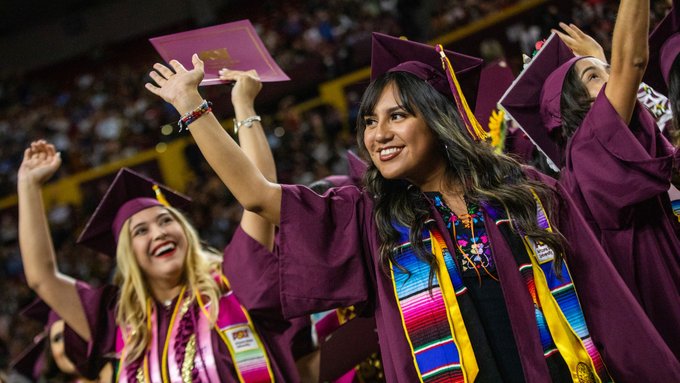
It’s official. Arizona State University has been named a Hispanic-Serving Institution (HSI) by the U.S. Department of Education. In 2021, ASU’s Hispanic students made up 26% of the immersion (on-campus) undergraduate population, up from about 19% in the fall of 2011, according to ASU.
ASU Online has also seen growth among Hispanic students, accounting for nearly 22% of total undergraduate online learners in fall 2021.
In terms of actual numbers of students, ASU has more than 16,840 Hispanic undergraduate students among its fall 2021 immersion population, compared with about 10,400 in fall 2011. When all students — undergrad and graduate, immersion and online — are included, ASU’s Hispanic enrollment stands at more than 30,200 students, a big increase from the roughly 12,240 such students in fall 2011.
“While we are excited to see enrollment of Hispanic students continue to increase, we are even more proud that their retention and graduation rates continue to rise as well,” said Nancy Gonzales, executive vice president and university provost, in a statement. “As a first-generation Latina graduate from ASU myself, it brings me great joy to see our community of talented and determined students thriving at ASU, and I look forward to the benefits that this university accomplishment will provide our academic community in the years to come.”
The median age of Hispanics living in Arizona is 28, and nearly half of the K–12 population identifies as Latino, making it even more crucial to support and prepare the state’s Latino population for college and careers.
This summer, in an effort to expand the reach of SummerUp Camps, ASU’s New College also hosted community college students from Compton College for a special STEM and college success camp. Last year, Compton College served over 6,600 students.
A majority of Compton College students are from underrepresented groups, with 63% of students identifying as Hispanic or Latino and 22% identifying as Black.
“This camp was the first of its kind for the West campus, so we were eager to give students a taste of university life while also creating a sense of belonging,” said Carolyn Starr, director of community events and experiential programming at the West campus. “Because so many of the participants were first-gen, we really wanted to help them to envision a future where graduating from a four-year university is within reach.”
From June 12–21, the participants took science-, technology-, engineering- and mathematics-related courses taught by New College faculty, ranging in topics from anatomy, ecology, and coding to geology and forensic science.
The U.S. Army Corps of Engineers has been tasked with…
Brown and Caldwell, a leading environmental engineering and construction firm,…
Humboldt State University, one of four campuses within the California…